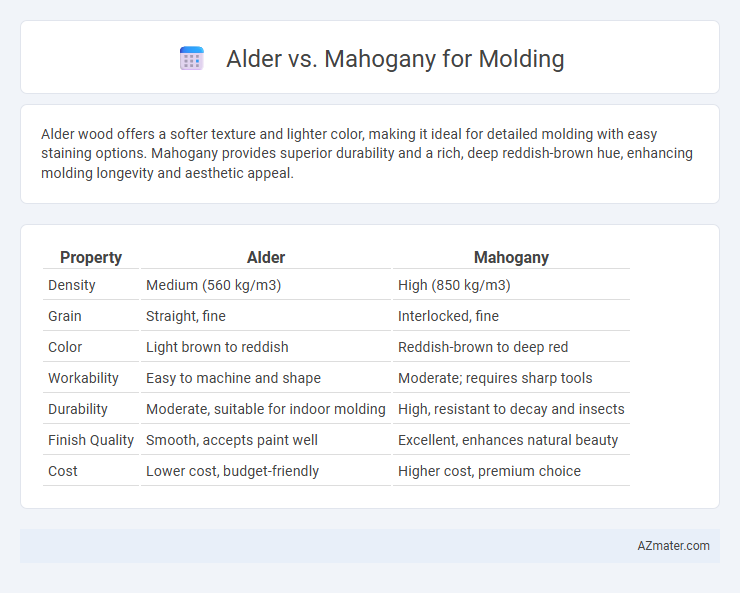Alder wood offers a softer texture and lighter color, making it ideal for detailed molding with easy staining options. Mahogany provides superior durability and a rich, deep reddish-brown hue, enhancing molding longevity and aesthetic appeal.
Table of Comparison
| Property | Alder | Mahogany |
|---|---|---|
| Density | Medium (560 kg/m3) | High (850 kg/m3) |
| Grain | Straight, fine | Interlocked, fine |
| Color | Light brown to reddish | Reddish-brown to deep red |
| Workability | Easy to machine and shape | Moderate; requires sharp tools |
| Durability | Moderate, suitable for indoor molding | High, resistant to decay and insects |
| Finish Quality | Smooth, accepts paint well | Excellent, enhances natural beauty |
| Cost | Lower cost, budget-friendly | Higher cost, premium choice |
Introduction: Alder vs Mahogany for Molding
Alder and mahogany are two popular wood choices for molding, each offering distinct aesthetic and functional qualities. Alder is known for its fine grain and smooth texture, making it easy to work with and ideal for staining or painting. Mahogany provides exceptional durability and rich, deep reddish-brown tones, making it a premium option for high-end, long-lasting moldings.
Wood Characteristics: Alder and Mahogany
Alder wood is known for its soft texture and uniform grain, making it easy to work with for detailed molding projects, and it typically displays a light, creamy brown color that darkens with age. Mahogany features a rich, reddish-brown hue with a straight, fine grain that provides high durability and resistance to warping, ideal for luxurious and long-lasting moldings. Both woods offer smooth finishes, but Mahogany's density and stability make it preferred for high-end applications where strength and longevity are critical.
Durability and Strength Comparison
Mahogany offers superior durability and strength for molding, known for its dense, tight grain that resists dents, scratches, and warping over time. Alder is softer and less dense, making it easier to work with but more prone to dents and wear in high-traffic areas. For long-lasting molding installations, mahogany delivers enhanced structural integrity compared to the moderately durable alder.
Appearance and Grain Patterns
Alder molding features a smooth, consistent grain with subtle knots, offering a warm, light-to-medium brown color that darkens with age. Mahogany molding showcases a rich, deep reddish-brown hue with a straight, interlocking grain pattern, providing a luxurious and elegant appearance. The choice between Alder and Mahogany for molding depends on whether a softer, more rustic look or a bold, classic finish is preferred.
Workability and Ease of Installation
Alder wood offers superior workability for molding due to its softer texture and fine, straight grain, making it easy to cut, shape, and sand with minimal effort. Mahogany, while harder and denser, provides excellent stability and durability but requires more precise tools and experience to avoid splintering during installation. Choosing alder speeds up the installation process for intricate profiles, whereas mahogany demands careful handling but delivers a long-lasting, premium finish.
Cost Differences and Affordability
Alder wood is generally more affordable than mahogany, making it a cost-effective choice for molding projects without sacrificing quality. Mahogany, known for its rich color and durability, commands a higher price due to its premium hardwood status and slower growth rate. When budget constraints are a priority, alder offers excellent value, while mahogany suits high-end applications where appearance and longevity justify the investment.
Finishing Options and Versatility
Alder offers smooth grain and takes stain evenly, making it ideal for a wide range of finishes from natural clear coats to dark stains, enhancing versatility in molding applications. Mahogany provides a rich, reddish-brown hue with a fine, straight grain that highlights intricate details when finished with oil or lacquer, adding a luxurious touch to moldings. Both woods suit diverse design aesthetics, but alder excels in adaptability due to its lighter color and responsiveness to various finishing techniques.
Environmental Impact and Sustainability
Alder wood is often considered more sustainable than mahogany due to its faster growth rate and greater availability, reducing pressure on endangered tropical forests. Mahogany, typically harvested from slow-growing tropical trees, faces criticism for deforestation and habitat loss, raising environmental concerns. Choosing alder for molding supports responsible forestry practices and lowers the carbon footprint associated with transportation and harvesting compared to mahogany.
Ideal Applications for Each Wood
Alder wood is ideal for molding in interior spaces requiring a warm, uniform appearance, such as classic and rustic home designs, due to its smooth grain and ease of staining. Mahogany suits high-end, formal settings where durability and a rich, deep reddish-brown finish are desired, making it perfect for luxury trim, architectural details, and traditional decor. Both woods offer excellent workability, but alder is preferred for more budget-friendly projects, whereas mahogany provides superior resistance to moisture and wear, ideal for long-lasting, elegant molding.
Final Recommendation: Choosing the Right Wood for Molding
Alder wood offers a soft texture and easy workability, making it ideal for detailed molding with a smooth finish, while mahogany provides exceptional durability and a rich, deep color perfect for high-end, long-lasting trim. For projects requiring budget-friendly, paint-ready options, alder is preferred; mahogany excels in stained, visible wood grain applications demanding elegance and strength. Consider the room's style, desired finish, and durability needs when selecting between alder and mahogany for molding to achieve the best balance of aesthetics and performance.

Infographic: Alder vs Mahogany for Molding
 azmater.com
azmater.com